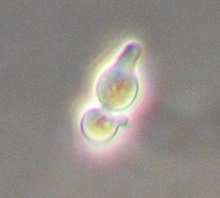
Back Accoppiamento del lievito Italian Koniugacja drożdży Polish Детерминация типов спаривания у дрожжей Russian

The mating of yeast, also known as yeast sexual reproduction, is a fundamental biological process that promotes genetic diversity and adaptation in yeast species. Yeasts such as Saccharomyces cerevisiae (baker's yeast) are single-celled eukaryotes that can exist as either haploid cells, which contain a single set of chromosomes, or diploid cells, which contain two sets of chromosomes. Haploid yeast cells come in two mating types, a and 'α', each producing specific pheromones to identify and interact with the opposite type, thus displaying simple sexual differentiation.[1] This mating type is determined by a specific genetic locus known as MAT, which governs the mating behaviour of the cells. Haploid yeast can switch mating types through a form of genetic recombination, allowing them to change mating type as often as every cell cycle. When two haploid cells of opposite mating types encounter each other, they undergo a complex signaling process that leads to cell fusion and the formation of a diploid cell. Diploid cells can then reproduce asexually or, under nutrient-limiting conditions, undergo meiosis to produce new haploid spores.
The differences between 'a' and 'α' cells, driven by specific gene expression patterns regulated by the MAT locus, are crucial for the mating process. Additionally, the decision to mate involves a highly sensitive and complex signaling pathway that includes pheromone detection and response mechanisms. In nature, yeast mating often occurs between closely related cells, although mating type switching and pheromone signaling allow for occasional outcrossing, enhancing genetic variation. Furthermore, certain yeast species, like Schizosaccharomyces pombe and Cryptococcus neoformans, have unique mating behaviours and regulatory mechanisms, demonstrating the diversity and adaptability of yeast reproductive strategies.
- ^ For the sake of clarity, this article bolds the Latin letter "a" and uses regular font weight for the Greek α. The usual convention is to print both in the same weight, but doing so would make the two letters hard to tell apart in italicized text.